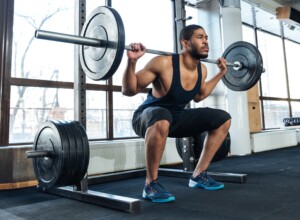
More and more people are having their tibias or shins surgically lengthened strictly for cosmetic purposes: that of being taller.
Surgical techniques for tibia lengthening have improved over the years, and people who desperately want to be taller are undergoing this painful procedure.
As a former personal trainer, and lifelong fitness buff, I am acutely aware of anthropometrics, particularly limb leverages as they apply to the back squat exercise.
I’ve already written quite a few articles on “long femurs,” meaning a femur longer than torso length will put a person at a biomechanical disadvantage in the back squat.

However, those whose femurs are equal in length to their torso, rather than longer, will still have a biomechanical disadvantage in the back squat — if their shins are disproportionately short for their whole leg.
The reason is that in order to keep from toppling backwards in a back squat, one must align their shoulders over their midfoot.
To put it another way, the foot has to get under the buttocks while squatting. The more under the buttocks the feet are, the less the athlete needs to lean forward.
Short Tibias Are a Disadvantage in the Back Squat
People with relatively short tibias can’t get their feet well under their butt. (Note “relatively” here; having “short shins” has NOTHING to do with overall body height; a tall person can have relatively short shins, and a short person can have relatively long, pedestal-like tibias),
To compensate in a back squat, they must lean far forward: not an efficient position for a back squat. Imagine someone with shins much shorter than their femurs.
Picture a profile of them squatting. Now “grow” their tibias to be longer than their femurs. What happens? Long tibias act as support pedestals for a back squat.
So would surgical tibial lengthening enhance one’s ability to do a back squat?
Well, from a biomechanical standpoint, the answer is yes if recovery is complete; longer tibia relative to femur means better leverage.
But does this mean it’s a smart idea to undergo surgical limb lengthening if both your limbs are the same length, your legs are straight (no bone deformity) and all you want is better anthropometrics for the back squat?
Doctor’s Perspective on Tibia Lengthening
“As you know, many MDs frown on back squats because people tend to get carried away and put too much strain on this often weak or conditioned set of muscles,” says Dr. Moshe Lewis, MD, board certified in physical medicine and rehabilitation.
“I don’t know too many orthopedic surgeons who recommend tibial lengthening sheerly for cosmetic reasons or being able to do squats.
“The patients I have who had these procedures typically have more than 2 inches leg length discrepancy, typically having had a fracture or hip surgery.”
Bottom line: Don’t even think of having your tibias surgically lengthened to improve your back squat.
You’d need to avoid weight lifting for two years following this procedure for complete recovery! And complete recovery isn’t even guaranteed.
Plus, the cost is astronomical and not covered by insurance.
 Dr. Lewis is the founder and CEO of Golden Gate Institute for Physical Medicine in CA, which provides education and clinical management of pain.
Dr. Lewis is the founder and CEO of Golden Gate Institute for Physical Medicine in CA, which provides education and clinical management of pain.
 Lorra Garrick is a former personal trainer certified through the American Council on Exercise. At Bally Total Fitness she trained women and men of all ages for fat loss, muscle building, fitness and improved health.
Lorra Garrick is a former personal trainer certified through the American Council on Exercise. At Bally Total Fitness she trained women and men of all ages for fat loss, muscle building, fitness and improved health.
.
Top image: Shutterstock/Dean Drobot


























